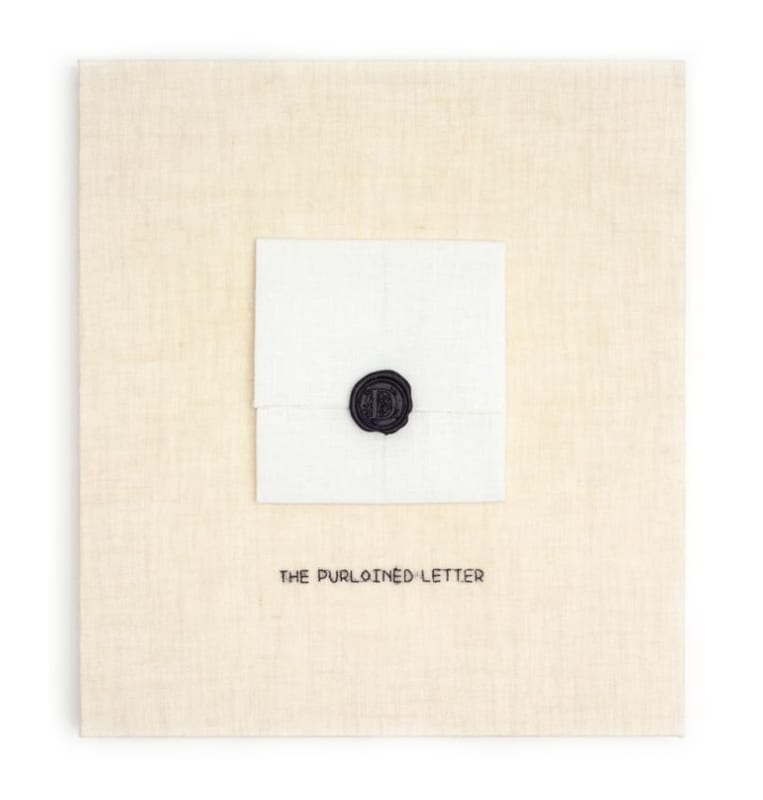Elaine Reichek reminds us that conceptual art may be about ideas, but it is still art. A look back at an archetypal example of conceptual art, René Magritte’s 1929 painting “La Trahison des Images” or “The Treachery of Images,” or “This Is Not a Pipe” — a parodic image of a pipe and a written denunciation that declares the image not to be the thing itself — signals Reichek’s point of departure.
Words can be treacherous. Reichek likes the idea that their meaning can change without warning, and the title of her current exhibition, Sight Unseen confirms this. Isolate the phrase and you get a metaphysical meditation on vision: the artist presents an image to be seen, not knowing if it will be seen. Or, the artist composes a work and then leaves it to the tender mercies of viewers, who will interpret the original however they like. Reichek alerts us that lurking in commonplace expressions like “sight unseen” are hidden ideas.
These thoughts coalesce in Reichek’s “The Purloined Letter,” (2017) a hand-embroidered image of an antique letter, complete with a wax seal. She translates Edgar Allan Poe’s letter, a floating signifier devoid of a signified (we never learn what the letter says), into a visual image. In the original narrative Poe’s detective Auguste Dupin sees “a solitary letter” that was:
[…] much soiled and crumpled. It was torn nearly in two, across the middle — as if a design, in the first instance, to tear it entirely up as worthless, had been altered, or stayed, in the second.
Except Reichek’s letter is pure white, intact, its seal unbroken. Jacques Lacan and Jacques Derrida battled mightily over the meaning of Poe’s letter in the pages of Yale French Studies (issues 48 and 52), Lacan the psychoanalyst declaring the invisible letter to possess meaning, Derrida the philosopher calling that conclusion into doubt. Reichek short-circuits their polemic by remitting Poe’s letter to a virginal state, before it was purloined, when it was still in the possession of the Queen. Rather than restoring the mangled letter to its rightful owner she announces it as a work of art, forever intact, as the invisible author leaves behind nothing but treacherous images.
“Oedipus Rex” (2019) also leaves a key element intact. Below a hand-embroidered eye, intact but red, is Oedipus’s final speech: “I stabbed out these eyes. Why should I have eyes? Why, when nothing I saw was worth seeing?” Why is Reichek’s eye as intact as Poe’s stolen letter? The familiar explanation of Oedipus’s self-blinding is that it is a displaced castration, so it may be that Reichek is simply referring to a wound that is better left unseen, and thus again to the phrase “sight unseen.” The artist leaves us with the commonplace “no one is blinder than those who will not see.”
Reichek’s play with presences that conjure absences and absences that are presences reappears constantly in the form of handwriting in this magnificent 30-piece show of modestly proportioned works (they range between 11 by 9 and 23 by 22 inches). She uses hand-embroidery to emulate the handwriting of authors whose ideas she makes her own, acting as a ghostwriter, not in the sense of composing a text signed by someone else, but of transmuting authorial handwriting into embroidery.
Elena Ferrante addresses the difference between anonymity and absence; anonymity means denying authorial identity. In “Absence (Elena Ferrante)” (2016) Reichek embroiders the author’s claim that she signs her books but leaves them to take their place in the world without accompanying them as a parent might guide a child: “what counts most for me is to preserve a creative space that seems full of possibilities. The structural absence of the author affects the writing in a way that I’d like to continue to explore.” Ferrante reprises what Borges says in “Borges and I,” (1960), that the name on the book’s spine is the name of the author, not of the person who wrote it. In “Absence,” Reichek embroiders the handwriting of a woman who steps aside from herself as author to avoid being linked to the printed text, whose meaning will be determined by the reader.
The artist performs the gesture of writing as actor, as reader, and as creator. Like Magritte’s denunciation, this is not Elena Ferrante but Elaine Reichek, sinking her identity into a vast panoply of identities — from Virginia Woolf to Anna Akhmatova to William Blake— and emerging with creations that are all her own, and that preserve both her signature style (embroidery) and her absence.

